Drawing a Molecule Surface
The 2D representation of the molecule surface is calculated by first drawing circles around each atom of the molecule and then identifying the external arc segments that define a continuous surface around the molecule. This process is illustrated in the table Table: Calculation of the 2D representation of a molecule surface
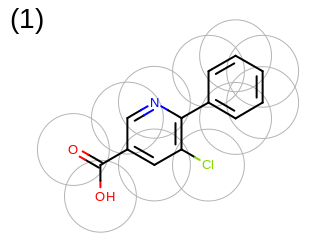
|
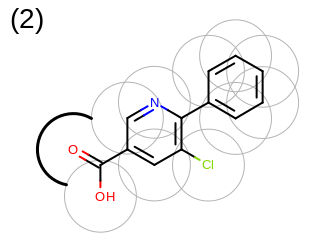
|
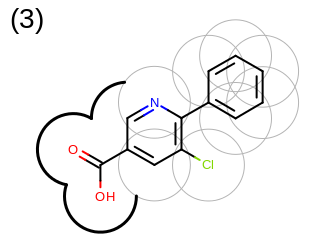
|
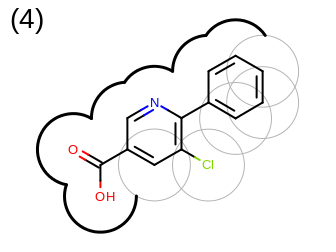
|
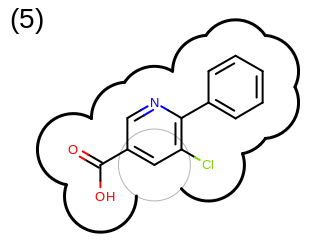
|
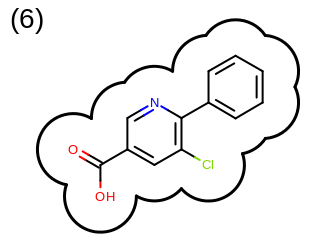
|
The following Listing 1 example shows how to
the display a molecule surface.
After creating an image object and preparing the molecule for 2D
depiction, an arc drawing functor is added to each atom of the
molecule by using the OESetSurfaceArcFxn
function.
The surface then can be drawn by calling the
OEDraw2DSurface function that calculates the
arc segments that form a continuous curve around the molecule.
The image created by Listing 1 is shown in
Figure: Example of surface drawing.
Listing 1: Example of surface drawing
double scale = OEScale.AutoScale;
OE2DMolDisplayOptions opts = new OE2DMolDisplayOptions(width, height, scale);
opts.SetTitleLocation(OETitleLocation.Hidden);
opts.SetScale(oegrapheme.OEGetMoleculeSurfaceScale(mol, opts));
OEPen pen = new OEPen(oechem.getOEGrey(), oechem.getOEGrey());
OEEyelashArcFxn arcfxn = new OEEyelashArcFxn(pen);
for (OEAtomBase atom : mol.GetAtoms()) {
oegrapheme.OESetSurfaceArcFxn(mol, atom, arcfxn);
}
OE2DMolDisplay disp = new OE2DMolDisplay(mol, opts);
oegrapheme.OEDraw2DSurface(disp);

Example of surface drawing
The Listing 1 example uses the
OESurfaceArcStyle.Eyelash style to draw the
molecule surface.
The following table lists all surface drawing styles that are
available in Grapheme TK.
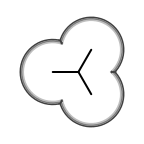
|
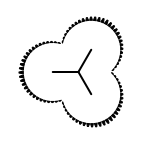
|
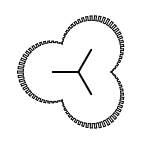
|
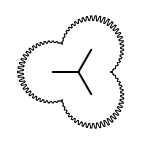
|
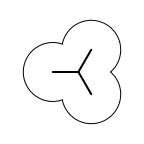
|
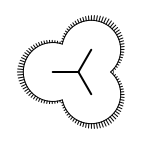
|
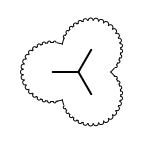
|

|

|

|
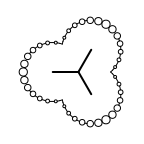
|
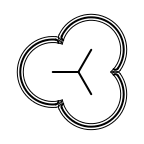
|
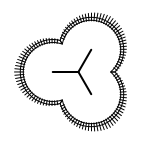
|
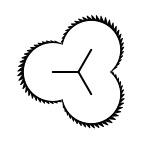
|
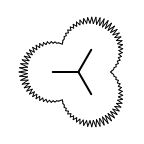
|

|
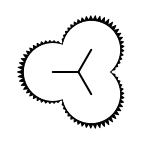
|
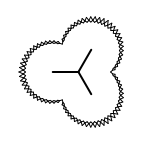
|
||
User-defined surface drawing functors can be implemented by deriving
from the OESurfaceArcFxnBase abstract base class.
In the Listing 2 example,
a user defined arc drawing functor is implemented that colors the
eyelash arcs according to the atom they belong to.
The image created by Listing 2 is shown in
Figure: Example of user-defined surface drawing.
Listing 2: Example of user-defined surface drawing
public static class AtomColorArcFxn extends OESurfaceArcFxnBase {
@Override
public boolean constCall(OEImageBase image, OESurfaceArc arc) {
OE2DAtomDisplay adisp = arc.GetAtomDisplay();
if (adisp == null || !adisp.IsVisible())
return false;
OEPen pen = new OEPen();
OEColor color = adisp.GetLabelFont().GetColor();
pen.SetForeColor(color);
OE2DPoint center = arc.GetCenter();
double radius = arc.GetRadius();
double bgnAngle = arc.GetBgnAngle();
double endAngle = arc.GetEndAngle();
oegrapheme.OEDrawEyelashSurfaceArc(image, center, bgnAngle, endAngle, radius, pen);
return true;
}
@Override
public OESurfaceArcFxnBase CreateCopy() {
AtomColorArcFxn copy = new AtomColorArcFxn();
copy.swigReleaseOwnership();
return copy;
}
}
static void draw2DSurface(OEImageBase image, OEMolBase mol) {
oedepict.OEPrepareDepiction(mol);
double scale = OEScale.AutoScale;
OE2DMolDisplayOptions opts = new OE2DMolDisplayOptions(image.GetWidth(), image.GetHeight(), scale);
opts.SetTitleLocation(OETitleLocation.Hidden);
opts.SetScale(oegrapheme.OEGetMoleculeSurfaceScale(mol, opts));
AtomColorArcFxn arcfxn = new AtomColorArcFxn();
for (OEAtomBase atom : mol.GetAtoms()) {
oegrapheme.OESetSurfaceArcFxn(mol, atom, arcfxn);
}
OE2DMolDisplay disp = new OE2DMolDisplay(mol, opts);
oegrapheme.OEDraw2DSurface(disp);
oedepict.OERenderMolecule(image, disp);
}
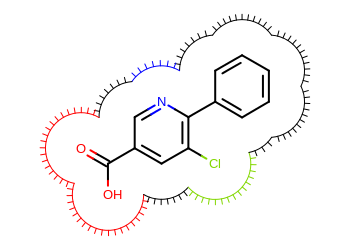
Example of user-defined surface drawing
The Listing 3 example shows
how to project atom properties, such as partial charges into the molecule
surface.
The image created by Listing 3 is shown in
Figure: Example of depicting atom properties.
Listing 3: Example of depicting atom properties on the molecule surface
private static class AtomPartialChargeArcFxn extends OESurfaceArcFxnBase {
private OELinearColorGradient colorg;
private AtomPartialChargeArcFxn() {}
public AtomPartialChargeArcFxn(OELinearColorGradient cg) {
colorg = new OELinearColorGradient(cg);
}
@Override
public boolean constCall(OEImageBase image, OESurfaceArc arc) {
OE2DAtomDisplay adisp = arc.GetAtomDisplay();
if (adisp == null || !adisp.IsVisible())
return false;
OEAtomBase atom = adisp.GetAtom();
if (atom == null)
return false;
double charge = atom.GetPartialCharge();
if (charge == 0.0)
return true;
OEColor color = colorg.GetColorAt(charge);
OEPen pen = new OEPen();
pen.SetForeColor(color);
pen.SetLineWidth(2.0);
OE2DPoint center = arc.GetCenter();
double bAngle = arc.GetBgnAngle();
double eAngle = arc.GetEndAngle();
double radius = arc.GetRadius();
double edgeAngle = 5.0;
int dir = OEPatternDirection.Outside;
double patternAngle = 10.0;
oegrapheme.OEDrawBrickRoadSurfaceArc(image, center, bAngle, eAngle, radius,
pen, edgeAngle, dir, patternAngle);
return true;
}
@Override
public OESurfaceArcFxnBase CreateCopy() {
AtomPartialChargeArcFxn copy = new AtomPartialChargeArcFxn(colorg);
copy.swigReleaseOwnership();
return copy;
}
}
static void draw2DSurfacePartialCharge(OEImageBase image, OEMolBase mol) {
oedepict.OEPrepareDepiction(mol);
oechem.OEMMFFAtomTypes(mol);
oechem.OEMMFF94PartialCharges(mol);
double scale = OEScale.AutoScale;
OE2DMolDisplayOptions opts = new OE2DMolDisplayOptions(image.GetWidth(), image.GetHeight(), scale);
opts.SetTitleLocation(OETitleLocation.Hidden);
opts.SetScale(oegrapheme.OEGetMoleculeSurfaceScale(mol, opts));
OEColorStop coloranion = new OEColorStop(-1.0, oechem.getOEDarkRed());
OEColorStop colorcation = new OEColorStop(+1.0, oechem.getOEDarkBlue());
OELinearColorGradient colorg = new OELinearColorGradient(coloranion, colorcation);
colorg.AddStop(new OEColorStop(0.0, oechem.getOEWhite()));
AtomPartialChargeArcFxn arcfxn = new AtomPartialChargeArcFxn(colorg);
for (OEAtomBase atom : mol.GetAtoms()) {
oegrapheme.OESetSurfaceArcFxn(mol, atom, arcfxn);
}
OE2DMolDisplay disp = new OE2DMolDisplay(mol, opts);
oegrapheme.OEDraw2DSurface(disp);
oedepict.OERenderMolecule(image, disp);
}
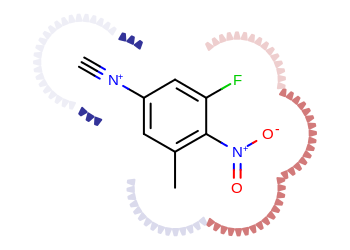
Example of depicting atom properties
See also
OELinearColorGradient class in the OEDepict TK manual
It is also possible to draw multiple 2D surfaces arc-by-arc.
In the Listing 4 example below the
arcs returned by the OEGet2DSurfaceArcs function
for the given atom display and radius are directly rendered below
the molecule diagram.
In this case it is important to call the OEGetMoleculeSurfaceScale
function with the largest radius scale of the 2D surfaces drawn.
This reduces the scaling of the molecule in order to able to fit the
molecule diagram and all of the arcs of the 2D surfaces into the image.
The image created by Listing 4 is shown in
Figure: Example of drawing multiple 2D surfaces.
Listing 4: Example of drawing multiple 2D surfaces
static void draw2DSurface(OE2DMolDisplay disp, OEUnaryAtomPred atompred,
double radius, OEColor color) {
OEPen penA = new OEPen(color, color, OEFill.Off, 2.0);
OEDefaultArcFxn arcfxnA = new OEDefaultArcFxn(penA);
OEColor grey = new OEColor(oechem.getOELightGrey());
OEPen penB = new OEPen(grey, grey, OEFill.Off, 2.0, OEStipple.ShortDash);
OEDefaultArcFxn arcfxnB = new OEDefaultArcFxn(penB);
OEImage layer = disp.GetLayer(OELayerPosition.Below);
for (OE2DAtomDisplay adisp : disp.GetAtomDisplays()) {
for (OESurfaceArc arc : oegrapheme.OEGet2DSurfaceArcs(disp, adisp, radius)) {
if (atompred.constCall(adisp.GetAtom()))
arcfxnA.constCall(layer, arc);
else
arcfxnB.constCall(layer, arc);
}
}
}
static void draw2DSurfaces(OEImageBase image, OEMolBase mol) {
oedepict.OEPrepareDepiction(mol);
double scale = OEScale.AutoScale;
OE2DMolDisplayOptions opts = new OE2DMolDisplayOptions(image.GetWidth(), image.GetHeight(), scale);
opts.SetTitleLocation(OETitleLocation.Hidden);
opts.SetScale(oegrapheme.OEGetMoleculeSurfaceScale(mol, opts, 1.50));
OE2DMolDisplay disp = new OE2DMolDisplay(mol, opts);
draw2DSurface(disp, new OEHasAtomicNum(OEElemNo.C), 1.00, oechem.getOEBlack());
draw2DSurface(disp, new OEHasAtomicNum(OEElemNo.N), 1.25, oechem.getOEDarkBlue());
draw2DSurface(disp, new OEHasAtomicNum(OEElemNo.O), 1.50, oechem.getOEDarkRed());
oedepict.OERenderMolecule(image, disp);
}
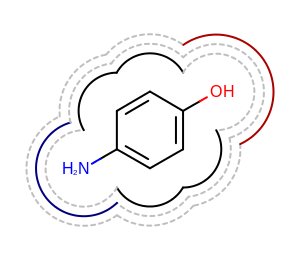
Example of drawing multiple 2D surfaces
See also
OESurfaceArcScale namespace
The last Listing 5 example shows how to
draw a 2D surface with various radii.
It draws two surfaces one with a minimum radius scale and one with various radius
depending on the covalent radius of the atoms.
The OEGetMoleculeSurfaceScale function has to be called
in this example too with the largest radius scale in order to able to fit the molecule diagram
and all of the arcs of the 2D surfaces into the image.
The image created by Listing 5 is shown in
Figure: Example of drawing 2D surface with various radii.
Listing 5: Example of drawing 2D surface with various radii
public static void drawSurfaces (OEImageBase image, OEMolBase mol) {
oechem.OEAssignCovalentRadii(mol);
double minradius = oechem.OEGetCovalentRadius(OEElemNo.H);
ArrayList<Double> radiusScales = new ArrayList<Double>(mol.GetMaxAtomIdx());
double maxrscale = Double.MIN_VALUE;
for (OEAtomBase atom : mol.GetAtoms()) {
double rscale = (atom.GetRadius() - minradius) + OESurfaceArcScale.Minimum;
radiusScales.add(atom.GetIdx(), rscale);
maxrscale = Math.max(maxrscale, rscale);
}
OE2DMolDisplayOptions opts = new OE2DMolDisplayOptions(image.GetWidth(),
image.GetHeight(), OEScale.AutoScale);
opts.SetTitleLocation(OETitleLocation.Hidden);
opts.SetScale(oegrapheme.OEGetMoleculeSurfaceScale(mol, opts, maxrscale));
OE2DMolDisplay disp = new OE2DMolDisplay(mol, opts);
OEImage layer = disp.GetLayer(OELayerPosition.Below);
OEPen penA = new OEPen(oechem.getOELightGrey(), oechem.getOELightGrey(), OEFill.Off, 2.0, OEStipple.ShortDash);
OEDefaultArcFxn arcfxnA = new OEDefaultArcFxn(penA);
for (OESurfaceArc arc : oegrapheme.OEGet2DSurfaceArcs(disp, OESurfaceArcScale.Minimum)) {
arcfxnA.constCall(layer, arc);
}
OEPen penB = new OEPen(oechem.getOEGrey(), oechem.getOEGrey(), OEFill.Off, 2.0);
OEDefaultArcFxn arcfxnB = new OEDefaultArcFxn(penB);
for (OESurfaceArc arc : oegrapheme.OEGet2DSurfaceArcs(disp, radiusScales)) {
arcfxnB.constCall(layer, arc);
}
oedepict.OERenderMolecule(image, disp);
}

Example of drawing 2D surface with various radii
See also
OEGetCovalentRadius function in the OEChem TK manual